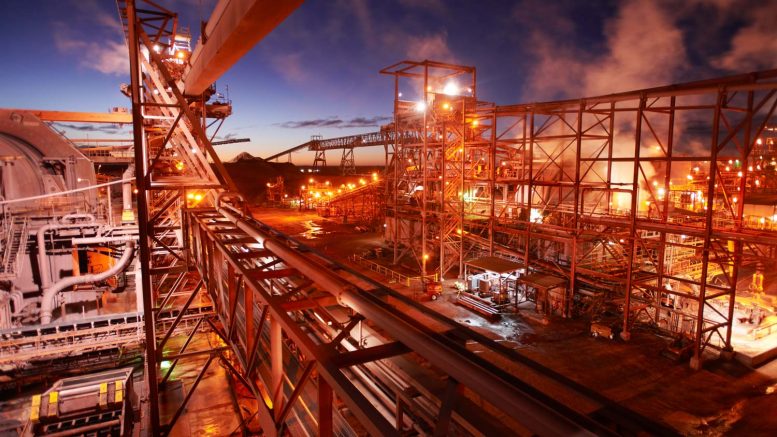A decade ago BHP Billiton was gearing up to dig the world’s biggest hole in the Australian outback.
In 2011, BHP delivered the largest annual profit in Australian corporate history and, like its peers, was flush with cash as China bought up metals and minerals at never seen before rates.
Iron ore prices appeared headed to US$200 per tonne, copper was setting records above US$4.50 per lb. (US$10,000 a tonne) and uranium averaged double today’s levels.
While other industries were still struggling to emerge from the global financial crisis, the late noughts and early 2010s were the acme of global mining.
And with megabucks came megadeals and megaprojects.
BHP acquired Olympic Dam, located 560 km north of Adelaide in South Australia, in 2005, and quickly looked for ways to expand, delivering a draft economic impact study for public scrutiny four years later.
The copper resource at Olympic Dam (a livestock watering hole named after the 1956 Melbourne Olympic Games) is considered the world’s fourth-largest, and its uranium resources, the world’s largest.
There is also more than a decent amount of gold and silver at Olympic Dam, and the expansion sailed through state and federal government permitting. An Olympic Dam Task Force was even set up to streamline the process further.
Olympic Dam Expansion – ODX – would place the operation in the top three globally, adding 515,000 tonnes of copper to underground output of over 200,000 tonnes.
But even during those heady days, the project came with an eye-popping price tag: US$30 billion.
Everything about ODX, which had its own glossy 22-page brochure, was grand in scale.
A new desalination plant running 100% on renewable energy with a 320 km pipeline, a 270 km transmission line, a 105 km rail line, a new airport to cater for large jets, a worker village, and an 8,000-strong workforce.
The project would also double the size of the nearby Roxby Downs township. There would be robots, too.
ODX was going to take an Olympian effort just to get to the orebody, with the first six years dedicated to removing overburden.
By 2050 the pit would grow to be 4.1 km long, 3.5 km wide and 1 km deep.
Waste rock piled 150 metres high would cover approximately 67 square kilometres.
The final feasibility was completed in May 2012, but by the time the Australian winter arrived, BHP was freezing capex budgets and institutional investors told companies spending like drunken soldiers to chill.
Deadlines for board approval were quietly missed as the industry tightened belts and by August of that year then CEO Marius Kloppers declared the company would look for less capital-intensive options.
One of those options, a previously discarded plan to add a giant heap leach operation, was put back on the drawing board where it remains today. The heap leach development trial only ended in June last year with results deemed “promising” but not much besides.
Kloppers’ successor Andrew Mackenzie was less than enthusiastic about the project, saying Olympic Dam needed a technological breakthrough before the economics would make sense.
In 2017, another inspiring acronym was introduced at Olympic Dam – BFX or Brownfield Expansion.
Modest in its ambitions, expanding surface infrastructure and extracting higher grade ore from the southern zone, the projected cost was less than a tenth of the open pit.
A level of uncertainty about the outcome of BFX was noticeable from the outset with potential annual output put anywhere from 240,000-350,000 tonnes. At US$2.5 billion for perhaps only 40,000 tonnes more, ODX seems a comparative bargain.
Then, last week, after three years of study and more than 400 km of drilling, BFX was axed, a decision tucked away in BHP’s quarterly production review.
“The studies have shown that the copper resources in the southern mine area are more structurally complex, and the higher grade zones less continuous than previously thought,” BHP said in its quarterly review. This was BHP trying to rationalize what a cruel mistress exploration can be.
“We have decided the optimal way forward for now is through targeted debottlenecking investments, plant upgrades and modernisation of our infrastructure,” BHP continued. This was BHP softening the body blow to South Australia and Roxby Downs with management catchphrases.
Not that Olympic Dam is not firing right now, with the mine’s best production results in years and a life still measured in decades.
There are also other options for BHP in the region. Perhaps sensing defeat for BFX, the company has uncharacteristically made much of its exploration success at Oak Dam, 60 km from the underground mine. BHP also said last week “the long-term opportunity for Olympic Dam is unchanged.”
But if long-term optimism about copper demand and prices, a narrow global pipeline of major projects, grades the envy of most large-scale mines, juicy gold credits and a uranium price that won’t go lower from here are not enough to clear a brownfield investment hurdle, what would?
With BFX kiboshed, the era of mining megaprojects seems well and truly over.
— This commentary first appeared in MINING.com, part of Glacier Resource Innovation Group.


Be the first to comment on "Commentary: How Olympic Dam went from mother of all digs to ‘debottlenecking’"